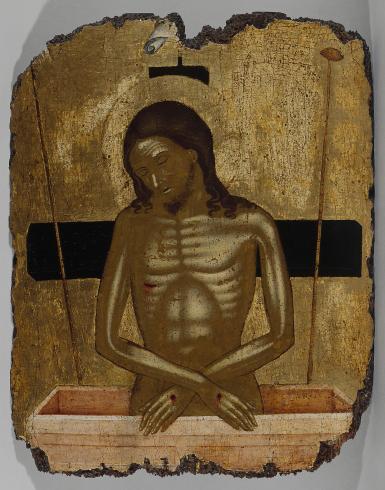The subject of the Christ of Pity was well-known in the Byzantine world from the 13th century. Linked to the cycle of the Passion, it was an image of devotion intended to be used for meditation on the death of Christ.
Christ is depicted facing forward, in a vertical position, the upper part of the body emerging from a porphyry sarcophagus, a stone reserved for emperors and a sign of his royalty. His inclined head and his closed eyes indicate that he has not yet been resurrected, and likewise his arms folded in front of him are suggestive of his position in the tomb. The stigmata of his passion – hands pierced by nails and a wound on his right side from the soldier’s lance – are highlighted by thin streams of blood. The leanness of the body of Christ evokes the suffering he endured, while his hair resting in curls on his shoulders softens this effect with its gentle waves. The scene is structured around the instruments of the Passion: The Cross, surmounted with the inscription “INRI” of which only the bottom remains, is painted behind the body; the sponge and the lance (the top of which is lost) frame Christ diagonally, producing an effect of perspective.
R. Z.

City of Paris municipal collection's website
The collections portal can be used to search the collections of Paris’s 14 municipal museums (approximately 336,000 works, including 43,000 belonging to the Petit Palais).
It is also possible to download around 12,000 images of the museum’s works free of charge.
Access the Museums of the City of Paris collections portal
Extern databases
Discover a selection of databases online presenting works from the Petit Palais or documents concerning the history of the museum.

